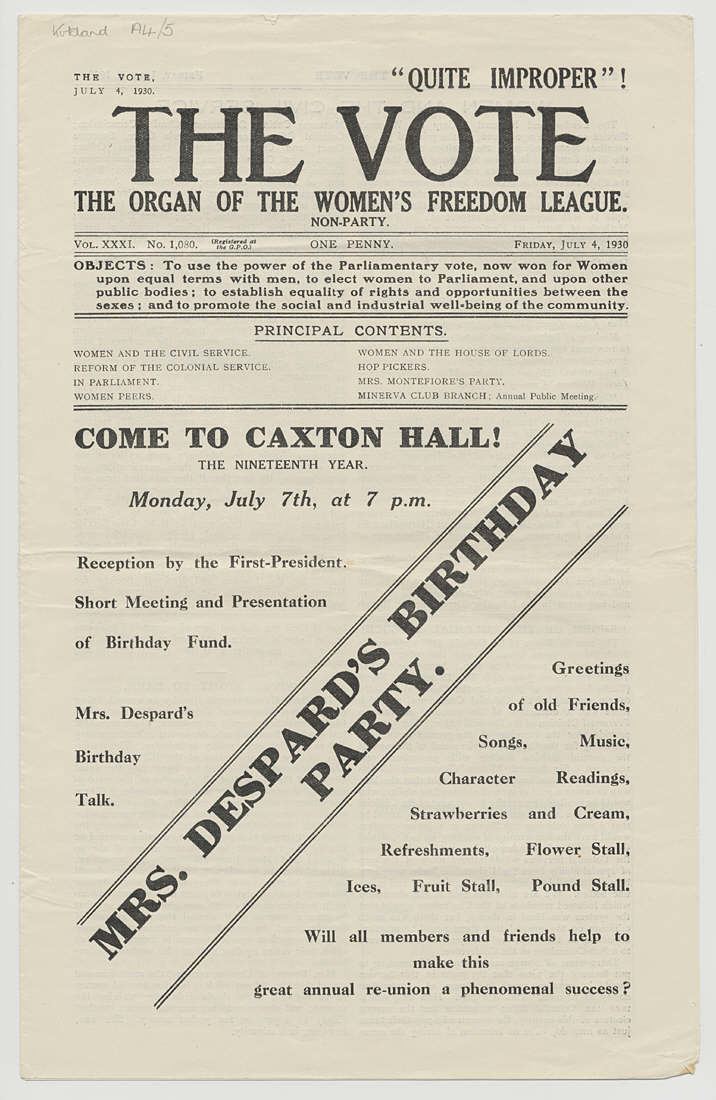 | ||
The Women's Freedom League was an organisation in the United Kingdom which campaigned for women's suffrage and sexual equality.
Contents
History
The group was founded in 1907 by seventy members of the Women's Social and Political Union (WSPU) including Teresa Billington-Greig, Charlotte Despard, Edith How-Martyn, and Margaret Nevinson. They disagreed with Christabel Pankhurst's announcement that the WSPU's annual conference was cancelled and that future decisions would be taken by a committee which she would appoint.
The League also opposed violence in favour of non-violent forms of protest such as non-payment of taxes, refusing to complete census forms and organising demonstrations, including members chaining themselves to objects in the Houses of Parliament. It grew to over 4,000 members and published weekly The Vote newspaper from 1909-1933. They continued their pacifism during World War I, supporting the Women's Peace Council. On the outbreak of war, they suspended their campaigns and undertook voluntary work, but in 1916 they restarted their lobbying activities.
In the 1918 general election, Despard, How-Martyn and Emily Frost Phipps stood unsuccessfully in London constituencies as independent women's rights anti-war candidates. They celebrated the achievement of suffrage and refocussed their activities on equality, including equal pay and equality of morality. The group declined in membership, but was not dissolved until 1961.
The Vote and the Growth in the Women's Freedom League
After the creation of the Women's Freedom League in 1907, it continued to grow rapidly throughout Great Britain. The league consisted of sixty branches and had nearly four thousand members. The league established its own newspaper called The Vote. Members of the League were writers, which led to the production of this newspaper. The Vote became the primary means of communication with the public, informing the public of campaigns, protests, and events. This newspaper also helped spread ideas concerning World War I, allowing for the Women's Freedom League to advocate against the war. Members of the League refused to become involved in campaigning efforts led by the British Army. Moreover, members were upset when their women’s suffrage campaign came to a halt while the war was occurring.
Protests and events
The League's main objective was to criticize, oppose and reform the government. The League held protests that advocated pacifism during World War I. Not only did the League oppose the war, but they also used peaceful forms of protest only such as refusing to complete census forms and not paying taxes. For example, in 1908 and 1909 the members chained themselves to various objects in Parliament in order to protest against the Government. On October 28, 1908, three members of the Women's Freedom League, Murial Matters, Violet Tillard, and Helen Fox, released a banner at the House of Commons. The women also chained themselves to the grille above a window. Law enforcement had to remove the grille while they were still attached until they could file off the locks that held them connected to the window. This protest became known as the Grille Incident.
Archives
The archives of the Women's Freedom League are held at The Women's Library at the Library of the London School of Economics, ref 2WFL
